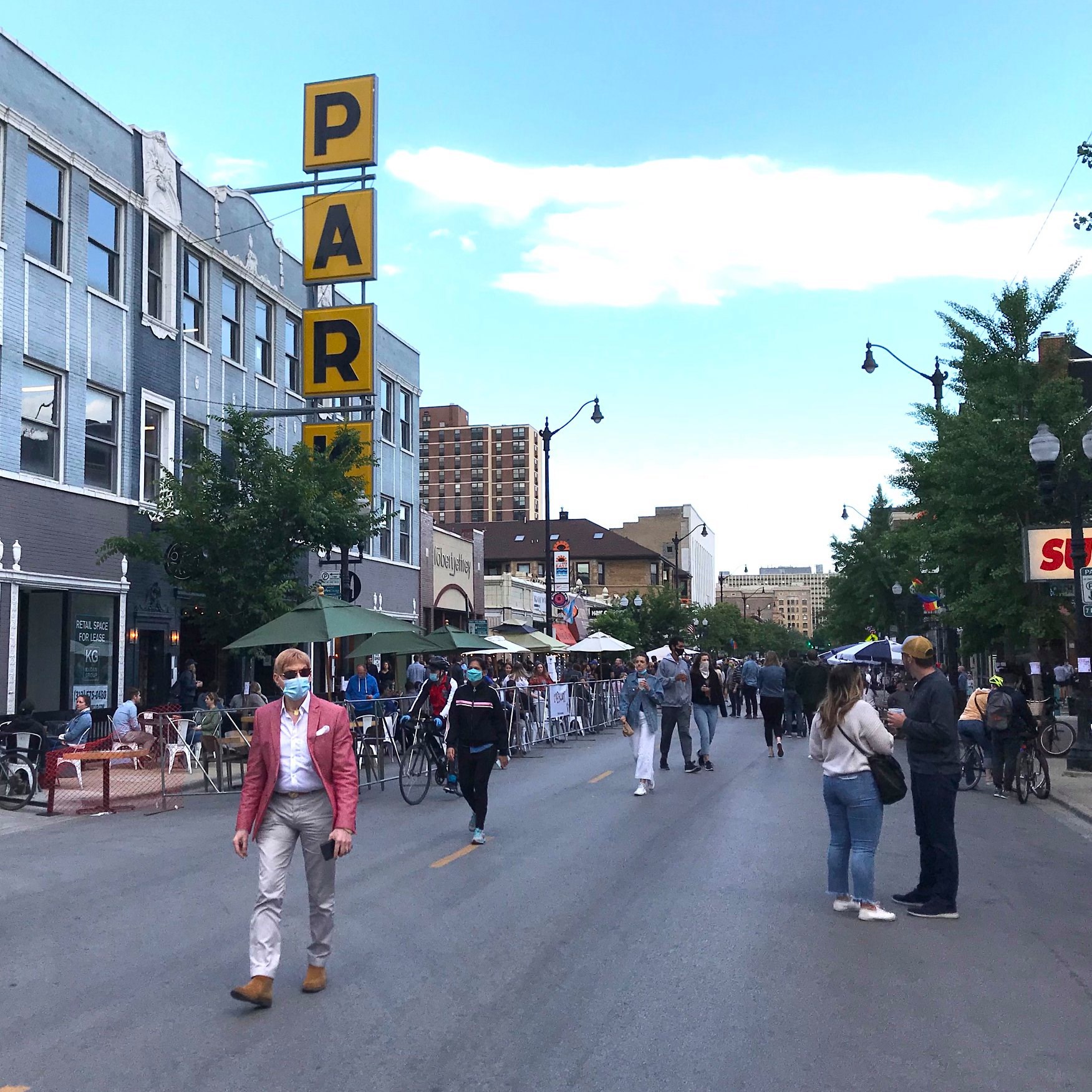Chicago has lagged behind peer cities on open streets initiatives to restrict or ban driving on roadways to make room for socially-distanced walking, biking, and dining. But the city has started to make up for lost time with the rollout of several Slow Streets and Cafe Streets in the past week.
The Drexel Slow Street
On Slow Streets (the Chicago Department of Transportation is calling them "Shared Streets), through traffic by drivers is prohibited so that people can walk, roll, jog, skate, scoot, and bike safely in the street, with enough room to stay at least six feet away from others. The city's first Slow Street debuted on Leland Avenue in Ravenswood on May 29.
Last Friday a new route opened paralleling the closed Bloomingdale Trail in Logan Square, using Cortland Street, Rockwell Street, Wabansia Avenue, and Marshfield Avenue in Logan Square and Bucktown. By Friday evening it was already getting good use from residents, including many families.
On Saturday, CDOT announced that it had installed the latest Slow Street on Drexel Boulevard between Oakwood Boulevard and 51st Street in the Oakland and Kenwood communities. This photo from Saturday the department tweeted out shows a number of families walking in the street.
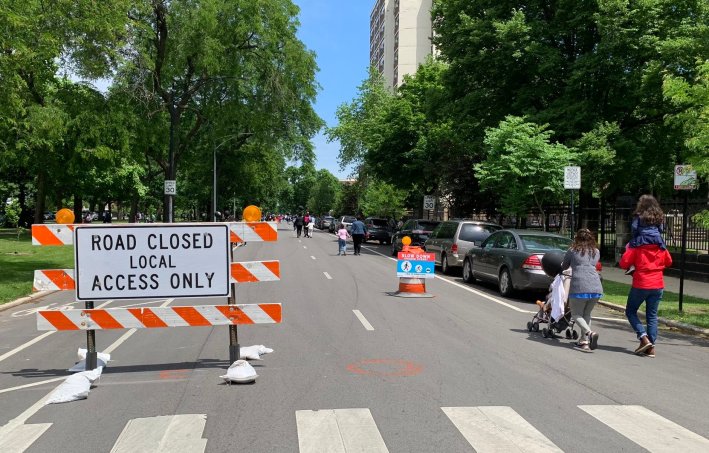
When I stopped by on my bicycle around dinner time Sunday, use was lighter, with many pedestrians using the path on the green space in the middle of the boulevard instead of the roadway. Even so, the addition of barricades and traffic barrels, which require drivers to slalom a bit, made biking on the street more relaxing, since speeding by drivers was a non-issue.
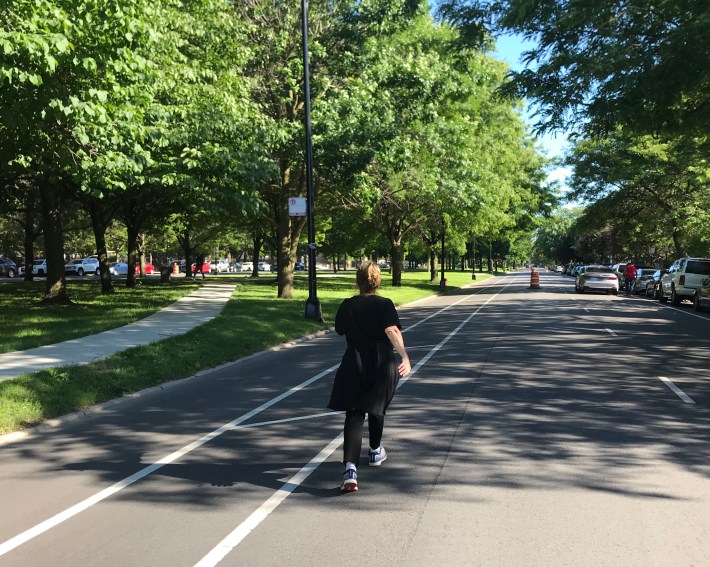
There are several churches along this stretch of Drexel, so it's possible that conflicts may arise between parking parishioners and Slow Street users may arise when the houses of worship are allowed to operate at full capacity again. But so far I haven't heard of any pushback to the project.
Cafe Streets
Last month the city announced six streets that would be temporarily pedestrianized to make room for cafe seating:
- Chatham: 75th Street from Calumet Avenue to Indiana Avenue
- Lakeview: Broadway from Belmont Avenue to Diversey Parkway
- Little Village: 26th Street from Central Park to Harding Avenue
- Rush and Division: Rush Street from Oak Street to Cedar Street
- Near West Side: Taylor Street from Loomis Street to Ashland Avenue
- West Loop: Randolph Street from Expressway no further than Elizabeth Street
On Friday that initiative finally launched. Broadway and parts of side streets were pedestrianized, making room for sidewalk cafes, some of them large enough to accommodate dozens of diners, making for a very buzzing scene in a city where residents are eager to enjoy some nightlife after a long period of sheltering in place.
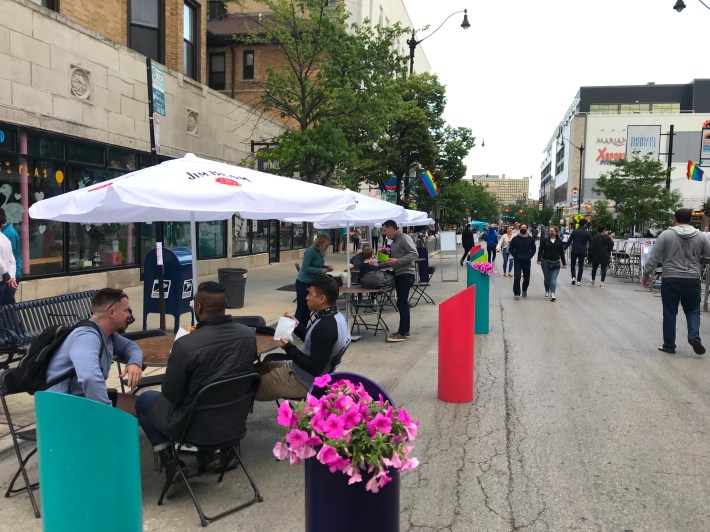
One minor downside of this setup is that you're not supposed to ride bikes on Broadway. Since the Lakefront Trail is officially closed until next Monday, that eliminates another north-south biking street, but nearby Inner Lake Shore Drive and Halsted Street are reasonable alternatives. The #36 Broadway bus is currently detouring between Belmont and Diversey via Belmont, Halsted, and Clark Street.
By Sunday the stretch of Rush by three-sided Mariano Park, widely known as the Viagra Triangle, had gone car-free as well. (According to an employee at Lem's Bar-B-Q on 75th Street, the street has not been pedestrianized yet, and they haven't gotten word yet on when it will be.) I'm not an epidemiologist, so I'll leave it up to the Chicago Department of Public Health to determine whether these Cafe Streets are successful from a pandemic safety standpoint.
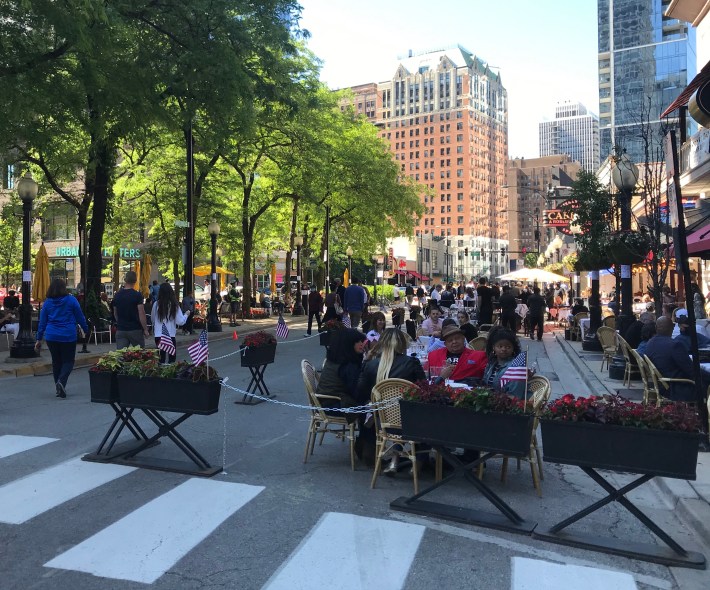
But they're certainly a hit from a public space standpoint, to the extent that I wouldn't be surprised if pedestrianizing these dining districts during the warmer months becomes the new normal. It wouldn't be the first time that someone has proposed making the Viagra Triangle car-free.
More outdoor dining initiatives
Back in April I suggested that the city help out struggling restauranteurs by making it cheaper and easier to have larger sidewalk cafes, provided that the dining areas don't obstruct pedestrians or people with disabilities.
Provided that the cafes don't block foot and wheelchair access, of course. Large cafes will allow tables to be spaced farther apart to make it safer and put people at ease. Maybe cut usual permit fees 50% to encourage participation? It might wind up being revenue-neutral. (2/2)
— John Greenfield (@greenfieldjohn) May 1, 2020
As it happens, Mayor Lightfoot has proposed an ordinance that would do almost exactly what I recommended. The legislation would speed up the permit process by removing the requirement for sidewalk café permit applications to be submitted to City Council before they're granted. It would reduce the fee for the permits by 75 percent, which is even greater than the 50 percent I proposed. And it would extend the boundaries of the cafe to allow them to occupy space in front of neighboring businesses, as long as the adjacent establishment doesn't sell food or liquor and don't block doors or windows. (That in turn would help keep the right of way clear for pedestrians by encouraging long, rather than wide, cafe zones.)
The Committee on Transportation and Public Way approved the ordinance last week, and the full City Council will likely rubber-stamp it this Wednesday.
